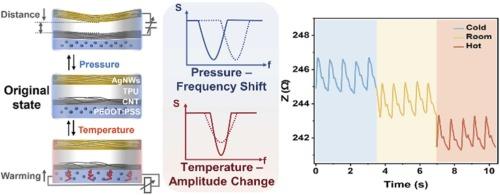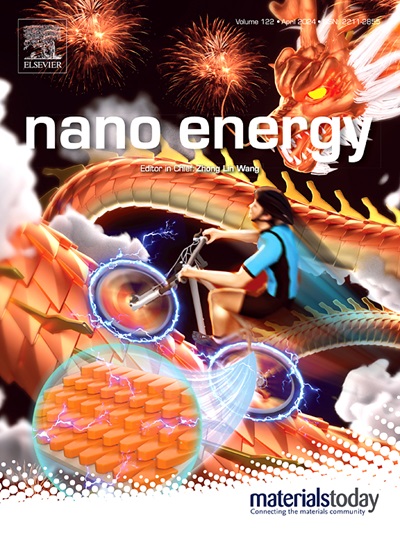利用调谐电路实现双模动态范围高精度检测的无电池柔性无线传感器
IF 16.8
1区 材料科学
Q1 CHEMISTRY, PHYSICAL
引用次数: 0
摘要
跟踪物体属性的动态范围在智能系统中起着至关重要的作用。然而,复杂性和分立电路仍然是实现微型集成和高精度检测的重大挑战。受 RFID 标签的启发,我们推出了一种可检测接触物体压力和温度参数的柔性无源无线传感器。该传感器具有基于同心纤维膜组件的电感器-电容器-电阻变化,可通过调整谐振电路实现频率和振幅偏移的精确解耦,从而实现 600 kPa 和 67 °C 的传感性能,压力限制为 1 Pa,温度限制为 0.1 °C。该传感器可与便携式矢量网络分析仪配对,用于无线电信号监测,因此具有广泛的实用性。这种设计策略为智能人机界面和个人健康监测提供了潜在应用。本文章由计算机程序翻译,如有差异,请以英文原文为准。

Battery-free flexible wireless sensors using tuning circuit for high-precision detection of dual-mode dynamic ranges
Tracking the dynamic range of properties in objects plays a crucial role in intelligent systems. However, complexity and discrete circuitry continue to pose significant challenges in achieving miniaturized integration and high-precision detection. Inspired by RFID tags, we introduce a flexible passive wireless sensor that detects pressure and temperature parameters of the contact object. The sensor features inductor-capacitor-resistance changes based on concentric fiber-membrane components for precisely decoupling frequency and amplitude shifts by tuning a resonant circuit, which enables a sensing performance for 600 kPa and 67 °C with distinguishing a pressure limit of 1 Pa and a temperature limit of 0.1 °C. The sensor can be paired with a portable vector network analyzer for wireless electrical signal monitoring, thus illustrating the broad utility. This design strategy enables potential applications in smart human-machine interfaces and personal health monitoring.
求助全文
通过发布文献求助,成功后即可免费获取论文全文。
去求助
来源期刊

Nano Energy
CHEMISTRY, PHYSICAL-NANOSCIENCE & NANOTECHNOLOGY
CiteScore
30.30
自引率
7.40%
发文量
1207
审稿时长
23 days
期刊介绍:
Nano Energy is a multidisciplinary, rapid-publication forum of original peer-reviewed contributions on the science and engineering of nanomaterials and nanodevices used in all forms of energy harvesting, conversion, storage, utilization and policy. Through its mixture of articles, reviews, communications, research news, and information on key developments, Nano Energy provides a comprehensive coverage of this exciting and dynamic field which joins nanoscience and nanotechnology with energy science. The journal is relevant to all those who are interested in nanomaterials solutions to the energy problem.
Nano Energy publishes original experimental and theoretical research on all aspects of energy-related research which utilizes nanomaterials and nanotechnology. Manuscripts of four types are considered: review articles which inform readers of the latest research and advances in energy science; rapid communications which feature exciting research breakthroughs in the field; full-length articles which report comprehensive research developments; and news and opinions which comment on topical issues or express views on the developments in related fields.
 求助内容:
求助内容: 应助结果提醒方式:
应助结果提醒方式:


